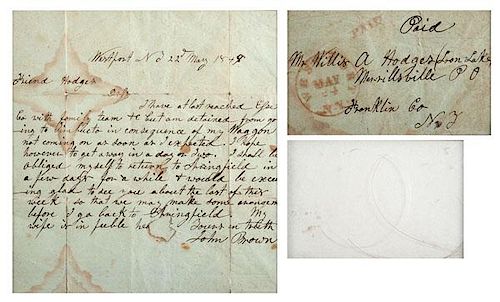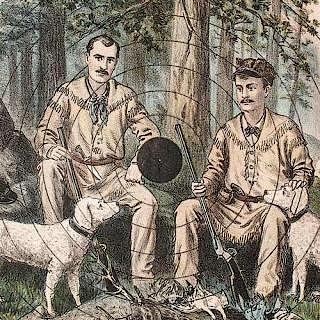John Brown ALS to African American Publisher of Abolitionist Newspaper, Plus
About Seller
6270 Este Ave.
Cincinnati , OH 45232
United States
With offices in Cincinnati, Cleveland and Denver, Cowan’s holds over 40 auctions each year, with annual sales exceeding $16M. We reach buyers around the globe, and take pride in our reputation for integrity, customer service and great results. A full-service house, Cowan’s Auctions specializes in Am...Read more
Two ways to bid:
- Leave a max absentee bid and the platform will bid on your behalf up to your maximum bid during the live auction.
- Bid live during the auction and your bids will be submitted real-time to the auctioneer.
Bid Increments
| Price | Bid Increment |
|---|---|
| $0 | $25 |
| $500 | $50 |
| $1,000 | $100 |
| $2,000 | $250 |
| $5,000 | $500 |
| $10,000 | $1,000 |
| $20,000 | $2,500 |
| $50,000 | $5,000 |
| $100,000 | $10,000 |
About Auction
Nov 20, 2015 - Nov 21, 2015
Cowan's Auctions dawnie@cowans.com
- Lot Description
John Brown ALS to African American Publisher of Abolitionist Newspaper, Plus
Brown, John (1800-1859). Abolitionist; hanged after attempting to incite slave rebellion at Harper's Ferry, VA. ALS, 1p, 7.125 x 7.625 in., Westport, NY. May 22, 1849. Accompanied by autograph addressed envelope Brown marked Paid, bearing a May 24 Westport roundstamp. In full:
I have at last reached Essex Co with family team &c. but am detained from going to Timbucto in consequence of my Waggon [sic] not coming on as soon as I expected. I hope however to get away in a day or two. I shall be obliged myself to return to Springfield in a few days for a while & would be exceedingly glad to see you about the last of this week so that we may make some arrangement before I go back to Springfield. My wife is in feeble hea[lth]. Your's in Truth/ John Brown.
The envelope is addressed: Mr. Willis A Hodges (Loon Lake)/ Merrillsville PO/ Franklin Co./ NY. In 1847, Willis A. Hodges (1801-1890) founded the abolitionist paper The Rams Horn, a weekly newspaper published and edited by Hodges, "A free Black born in Virginia, his family moved to New York in the mid-1830s after Nat Turner's rebellion...By the 1840s, Hodges functioned as one of the most outspoken advocates for abolition and equal rights in the State. His abolitionist newspaper caught the eye of Frederick Douglass and John Brown, both of whom contributed articles and funds...the paper reached a peak circulation of 2500...After the paper ceased publication, Hodges continued to support abolitionist causes, including Brown. It is not known if Hodges was part of the Harpers Ferry planning, but when Brown was arrested in 1859, Hodges burned their correspondence...The editor may have helped the US army as a scout in Virginia during the Civil War, but the evidence is uncertain. After the war, he was active in Virginia politics during the Reconstruction era and after the Democratic Party regained power in Virginia, he returned to New York in 1876, where he lived until his death in 1890." (from Blackvoicenews.com.)
At the time of this letter, Brown and his family were settled in a black community founded in North Elba on land donated by the Anti-Slavery campaigner, Gerrit Smith (1797-1879). When there, Brown developed strong opinions about the evils of slavery and gradually became convinced that it would be necessary to use force to overthrow this system.
Overall, a strong letter, with great association interest, from a desirable and uncommon historical figure, whose actions had a profound effect on the South's fight to disunion - both R.E. Lee and John Wilkes Booth were present at the hanging. Brown's ink writing is dark and bold.
The letter and cover are framed with what purports to be a few strands of Brown's hair, although this cannot be verified. Overall, the framed grouping measures 18.5 x 14 in.Letter and cover not examined outside of frame. Expected folds in letter, which may have some separation along the folds, few small holes at folds are visible. Some water stains in letter and on cover.Condition
- Shipping Info
-
SHIPPING. At the request of the buyer, Cowan's will authorize the shipment of purchased items. Shipments usually occur within two weeks after payment has been received. Shipment is generally made via UPS Ground service. Unless buyer gives special instructions, the shipping method shall be at the sole discretion of Cowan's Auctions, Inc.. Cowan's is in no way responsible for the acts or omissions of independent handlers, packers or shippers of purchased items or for any loss, damage or delay from the packing or shipping of any property.
-
- Buyer's Premium



 EUR
EUR CAD
CAD AUD
AUD GBP
GBP MXN
MXN HKD
HKD CNY
CNY MYR
MYR SEK
SEK SGD
SGD CHF
CHF THB
THB












